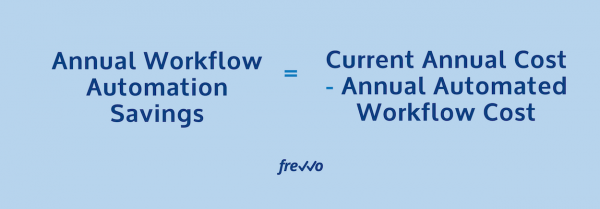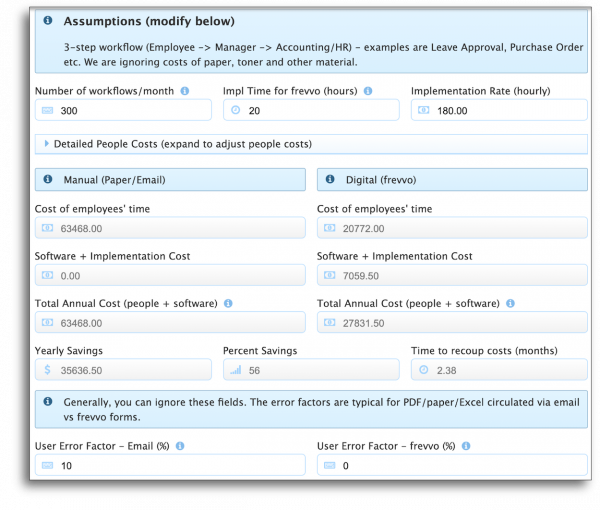Like most big business decisions, implementing business process automation (BPA) involves taking a lot of moving parts into consideration.
In addition to the capital investment required, integrating BPA means changing the way your organization operates, learning how to use new software, and training staff to follow new procedures.
For stakeholders unfamiliar with the benefits of workflow automation, it may seem like a big investment and a lot of change. Naturally, they’ll question whether it’s worth it. As a result, it can be hard to make a solid business case without an accurate idea of the kind of return on investment you’re looking at. Usually, that means providing hard numbers.
Being able to calculate your ROI is crucial – whether you’re trying to decide if investing in workflow automation is worth it, or you need to determine whether your existing automation project is paying off.
Fortunately, it’s easy to calculate workflow automation’s potential ROI with frevvo’s ROI calculator.
Keep reading to learn how to calculate your estimated ROI and get buy-in from even the most skeptical executives.
Measure Your Workflow Success
Calculating the return on investment on your workflow automation really comes down to measuring whether the upgrades you have made (or plan to make) to workflows have had (or will have) the intended effect.
When it comes to workflow automation, there are two types of ROI: soft and hard.
Soft ROI
Soft ROI refers to improvements to working conditions and outcomes that are difficult to measure and quantify. These range from overall efficiency gains to improved morale and higher customer satisfaction.
Soft ROI metrics might include:
- Higher efficiency and productivity
- Improved brand reputation
- More visibility and accountability
- Better team collaboration
- Fewer bottlenecks
- More adherence to policies
- Less fraud
- Higher morale and better company culture
- More satisfied customers
Perhaps you’re thinking that these returns could be measured through tools like surveys and net promoter scores, and you’re not wrong. The trouble is that even if you get a fairly accurate metric, it’s difficult to attribute these improvements specifically to workflow automation. Tempting as it might be to make this connection, correlation does not equal causation.
While these improvements are certainly important, they’re not enough to make your case.
Hard ROI
Hard ROI is far easier to calculate because it deals with things you can objectively measure such as time and cost savings.
Hard ROI metrics might include:
- Time saved per task/request
- Overall process cost savings
- Rate of workflow completion
- Rate of workflow approval/rejection
- Office operations costs (printing, paper, maintenance, storage)
- Role reduction (e.g. data entry roles)
The main purpose of workflow automation is to save you time – and therefore money – by making your workflows as efficient as possible.
This means that measuring the success (and ROI) of your workflow automation largely comes down to calculating time savings. Of course, you may see additional cost savings in things like paper and printing costs and early invoice payment discounts. Plus, there are less tangible savings gained by avoiding opportunity costs caused by delays. For simplicity, we’ve excluded these types of savings from our calculations.
How to Calculate Workflow Automation ROI
Calculating ROI for the automation of a workflow is far more straightforward than you might think. We’ll first walk you through how to perform the calculation manually and then show you how to use frevvo’s Workflow ROI Calculator to do it for you.
Step One: Calculate Your Current Annual Workflow Cost
To measure return on investment, you first need to know how long each workflow – and each task therein – takes to complete before implementing automation.
Run through each workflow with the employee(s) generally responsible for executing them and calculate how many minutes it typically takes them to complete it.
Once you have this benchmark, you can work out how much it costs you in employee wages. Remember to account for each employee in the workflow’s individual pay grade – fully loaded to account for benefits, vacation time, taxes, etc.

The calculation looks like this:
Current annual workflow cost = time (how long each step of the process takes) x cost (employee cost per hour) x frequency (how often the workflow is performed monthly) x 12 (months).

Step Two: Determine Time Savings
Once you have your benchmark, you can estimate how automation will reduce the time spent on each task in the workflow. This, in turn, lets you work out how much less each step in the workflow costs in employee wages.

Using the same calculation as in step one, work out how much your automated workflow costs. Remember to add the cost of your workflow automation software and implementation to the total annual cost.
The calculation looks like this:
Current annual workflow cost = time (how long each step of the process takes) x cost (employee cost per hour) x frequency (how often the workflow is performed monthly) x 12 (months) + total software and implementation costs.

Step Three: Calculate the Difference
Subtract the second number from the first, and you’ve calculated your annual savings.

Step Four: Calculate Your ROI
To calculate your ROI, you’ll simply divide your net savings by the cost of your investment (the cost of software and implementation) and multiply the result by 100 to get a percentage.

Our ROI Calculator tool also automatically calculates your monthly savings and how long it will take to recoup your investment (in months).
Step Five: Put It All Together
Now that you know how to calculate ROI for a single workflow, you can apply the same formula to all of your workflows or estimate ROI for new automating additional workflows.
Add all these subtotals together to calculate how much time and money your workflow automation saves (or could potentially save) per year. Of course, tracking ROI year-on-year makes it much easier to get future automation projects approved.

How to Use Frevvo’s Workflow Automation ROI Calculator
Now you know how to do it, but why do all those calculations manually when you can simply use frevvo’s ROI calculator? Simply input your data and quickly see how much you’ll save per workflow, per year.
We’ll walk you through each step below.
Step One: Input Software and Implementation Costs
For an estimate of what frevvo will cost to implement per workflow, simply input your estimation of the number of workflows/forms submitted per month. The form will automatically adjust the software and implementation cost accordingly.
Step Two: Input People Costs
First, expand the “Detailed People Costs” dropdown. Add each person involved in the workflow you want to calculate. Include how many minutes they typically spend completing their stage of the workflow, as well as their fully weighted salary. For now, ignore the steps that mention frevvo.
The form will automatically calculate the net user cost for each stage of the workflow according to the employee cost.
This example only contains three people, but you can add as many as you need.


Step Three: Input Time Spent with frevvo
Next, input how long it takes to perform the same workflow stages with frevvo’s workflow automation in place. Again, the form will calculate the net user cost.
If you’re already using frevvo, you can find accurate averages in your workflow reports. If you’re new to workflow automation and need help estimating time savings, one of our consultants would be happy to help you, at no obligation.

Step Four: Calculate Your ROI
Once you’ve added all the information, you’ll see the total annual cost of your software on the left and the cost with frevvo on the right at the bottom of the form.
You’ll find your annual savings in the “Yearly Savings” field and the percentage saved and time to recoup your investment to the right of that.
You can easily export this form as a PDF to use as you need.

Step Five: Add It All Up
This calculation is only for one automated workflow. Repeat the process to determine the total ROI on all your automated workflows and add it all up to calculate your total annual workflow automation returns.
Ready to start automating? Try our 100% free automation ROI calculator to see how much money you can save with workflow automation.

The post How to Calculate the ROI of Workflow Automation appeared first on frevvo Blog.




